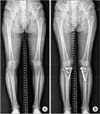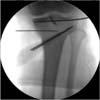Abstract
High tibial osteotomy is an established method in treatment of medial knee osteoarthritis with varus deformity in younger patients. The popliteal artery is vulnerable to injury during surgeries performed around the knee joint. Pseudoaneurysm of the popliteal artery following medial opening wedge high tibial osteotomy is rare. A femoral angiogram revealed a pseudoaneurysm arising from the popliteal artery near the osteotomy site. Careful placement of retractors around the osteotomy site during sawing and flexing the knee to displace the popliteal artery away are recommended to prevent this complication. We report on the case of a pseudoaneurysm of the popliteal artery complicating medial opening wedge high tibial osteotomy that was treated clinically and radio-graphically with literature reviews.
Figures and Tables
Figure 1
Preoperative magnetic resonance imaging. (A) A longitudinal horizontal tear is present from body to posterior horn. (B) A radial tear is present at the posterior horn of the lateral meniscus.

Figure 2
Pre- and postoperative scenography. (A) The femorotibial angle measured 8° on the right and 5.8° on the left of anatomical varus. (B) Postoperative standing radiographs showing satisfactory correction of the varus deformity.

Figure 3
Preoperative radiographs of both knees. The Rosenberg view of both knees shows mild gonarthrosis of both knees. PA, posterioranterior.

Figure 4
Postoperative radiographs of both knees. Preoperative varus gonarthrosis is well corrected by open wedge high tibial osteotomy fixed with an anatomical plate.

Figure 5
Lower extremity nonenhanced computed tomography. Approximately 6-cm-sized, ill-defined round isodense mass like lesion at the soleus muscle area of the proximal tibia level.

Figure 6
(A) Femoral angiography study showing a pseudoaneurysm (11.5×8.5-cm-sized) from the popliteal artery with the neck just near the lateral end of the osteotomy site. (B, C) Femoral angiography shows complete obliteration of the pseudoaneurysm after placing a stent in the popliteal artery.

References
1. Jackson JP, Waugh W. Tibial osteotomy for osteoarthritis of the knee. J Bone Joint Surg Br. 1961; 43:746–751.
2. Coventry MB. Osteotomy about the knee for degenerative and rheumatoid arthritis. J Bone Joint Surg Am. 1973; 55:23–48.
3. Shin YS, Lee DH, Lee SH, Kim MJ, Han SB. Basic principles and current trends of medial opening-wedge high tibial osteotomy. J Korean Orthop Assoc. 2014; 49:85–94.
4. van Dorp KB, Breugem SJ, Driessen MJ. Popliteal pseudoaneurysm after arthroscopic posterior cruciate ligament reconstruction. Knee Surg Relat Res. 2014; 26:187–189.
5. Shenoy PM, Oh HK, Choi JY, et al. Pseudoaneurysm of the popliteal artery complicating medial opening wedge high tibial osteotomy. Orthopedics. 2009; 32:442.
6. Shin YS, Hwang YG, Savale AP, Han SB. Popliteal artery pseudoaneurysm following primary total knee arthroplasty. Knee Surg Relat Res. 2014; 26:117–120.
7. Lee GC, Kim DH, Park SH. Popliteal artery pseudoaneurysm after anterior cruciate ligament re-revision using a rigidfix cross pin. Knee Surg Relat Res. 2014; 26:121–124.
8. Tejero-Garcia S, Lirola Criado JF, Ast MP, Fernandez de. Popliteal pseudoaneurysm after unicompartmental knee replacement: a case report. Knee. 2014; 21:597–599.
9. Kim J, Allaire R, Harner CD. Vascular safety during high tibial osteotomy: a cadaveric angiographic study. Am J Sports Med. 2010; 38:810–815.




 PDF
PDF ePub
ePub Citation
Citation Print
Print




 XML Download
XML Download